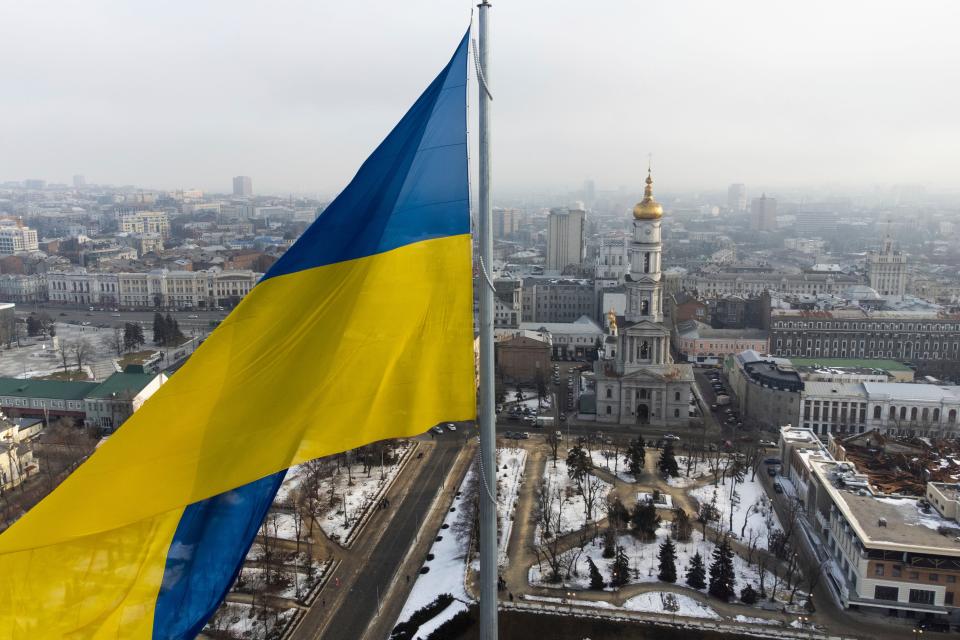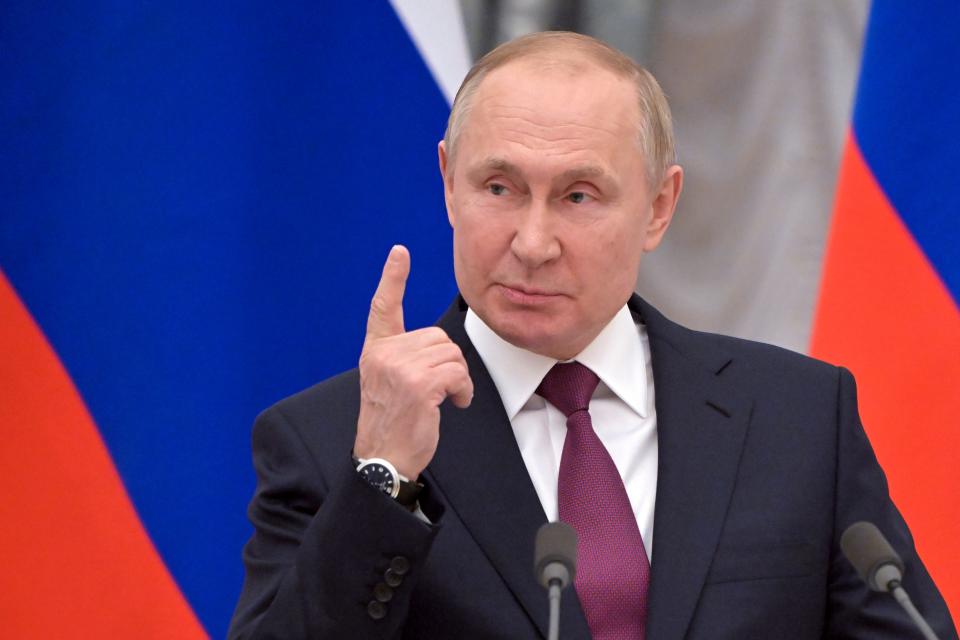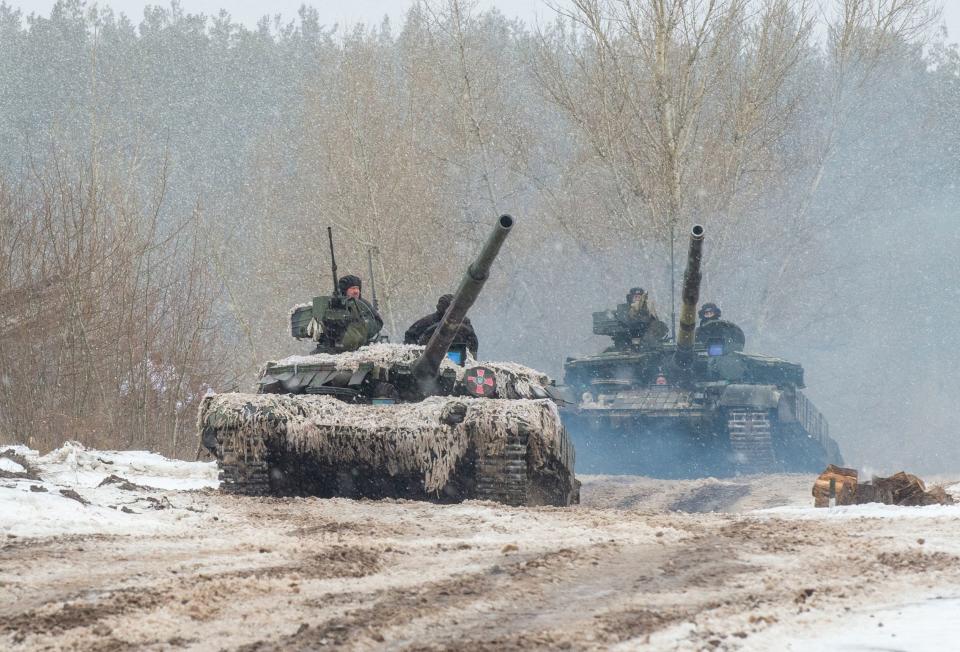Cyberattacks and disinformation are everyday tactics for Putin's Russia. Is that the future of war?
- Oops!Something went wrong.Please try again later.
WASHINGTON – The U.S. and its NATO allies have been warning for days about an imminent Russian invasion of Ukraine, raising the specter of massive civilian casualties and widespread suffering in the event of a war in Europe.
But the estimated 150,000 Russian troops massed on Ukraine's border aren't the only possible weapons the Kremlin has at the ready as it threatens its smaller neighbor.
National security experts believe Vladimir Putin has already launched a potentially devastating battle of a different kind – a “hybrid war” in which cyberweapons and disinformation could help him topple his vulnerable neighbor with far fewer shots fired.
“They've already started,” said Rolf Mowatt-Larssen, who knows the Russian leader well from his years as chief of the CIA’s Moscow station.
“While some of us have been familiar with Putin’s playbook for some time, the whole world is now getting introduced to the idea of hybrid war. And we're actually seeing it play out in real time,” Mowatt-Larssen said.
Those unconventional weapons are now permanent features of modern combat, and in the case of Ukraine, the results could be a horrific.
Already, social media posts accusing Ukrainians of fascism, genocide and being puppets of a militant West have gone viral online as Putin works to justify an invasion of the country, experts say.
"There has to be a narrative to sell to the Russian public and the world about why whatever action Russia takes is ultimately justified," said Samuel Charap, a senior fellow at the RAND Corporation, a research institution.
Meanwhile, a series of cyberattacks on Ukrainian government sites and financial institutions unfolded earlier this week in what many saw as a Russian-backed effort to destabilize Kyiv.
On Friday, the White House for the first time blamed Russia for those attacks, with national security officials suggesting it was part of a broader cyber offensive that could presage a military attack.
“Russia does use cyber as part of its projection of force... We may see further destabilizing or destructive cyber activities," White House deputy national security adviser Anne Neuberger said at a White House briefing Friday.
Those attacks should be seen as a "softening" of the country's infrastructure and a "preparing of the battlefield, so to speak," should Putin decide to wage a conventional military attack, Charap said.
The spark for wider war?: Why Americans should care about Russia's aggression against Ukraine
Putin has spent decades perfecting the art of hybrid warfare, which combines military action with cyberweapons and information operations that can disable an enemy in minutes, according to Mowatt-Larssen and other current and former U.S. intelligence officials.
"He could turn out the lights in Ukraine before it even knows what’s happening,” Mowatt-Larssen said.
"No war will ever again happen without a cyber component," said Paul Rosenzweig, a former senior Department of Homeland Security official. "And what that means is that war no longer has a battlefield and a frontline."

'Swift and severe costs': Here's what the US response might look like

Russia has been a pioneer in disinformation
Nina Jankowicz, a fellow at the Wilson Center, says Russia is “well-practiced” in disinformation dating back to the Soviet Union era, and the Kremlin's operatives have been “pioneers” in delivering those messages in the Internet era.
The disinformation tactics the Kremlin deploys today look different from earlier conflicts, though, including the 2014 annexation of Crimea, she said.
At that time, much of the Russian disinformation circulated online through the kinds of trolls and bots social media platforms are better-equipped to detect and neutralize today. Now, it comes from the top levels in the Kremlin and fans out through Russian-affiliated Western media sites and social media influencers, she said.
“It is not as simple as playing whack-a-troll, which is what we focused on for many years,” said Jankowicz, the author of a book on Russian disinformation who has worked with the Ukrainian government.
Clint Watts, a distinguished research fellow at the Foreign Policy Research Institute, told USA TODAY the Kremlin is targeting different audiences and languages with unique messages in the Ukraine conflict.
In Russian-speaking social media circles, the messages aim to justify war in response to alleged provocations from the West. Inside Ukraine and along its border, the disinformation targets pro-Russian audiences to counter Ukraine and prime the pump for conflict, he said.
Disinformation "is a paramilitary instrument of war against Ukraine, intended to delegitimize Ukraine’s sovereignty and completely dehumanize Ukrainians," wrote Yevhen Fedchenko, the editor-in-chief of StopFake, a fact-checking site that counters Russian disinformation campaigns, in a recent blog post.
While experts note Russian disinformation campaigns have been waged on Western countries at pivotal moments, including the United States, their most dire impact has often been felt in post-Soviet countries and Russia itself, where Putin uses disinformation to hold onto power, sow confusion and manufacture consent for his agenda, according to Kasey Stricklin, a research analyst at the non-profit research group CNA.
Homeland Security warning:Russia could launch cyberattack against US
A shock-and-awe cyber attack?
Putin has also been honing his cyber warfare skills for more than a decade, including a 2008 attack on Georgia that began with a shock-and-awe style cyber-offensive that took down military communications and multiple government websites – including the one the Georgian president used to communicate with his citizens.
Experts believe Putin was also behind attacks in Estonia and other Baltic nations, although authorities have not been able to definitively attribute them to Russia.
Putin’s biggest and most longstanding hybrid warfare target has always been Ukraine, according to Mowatt-Larssen and other intelligence and military officials.
Russia used cyberweapons against Ukraine to soften up Crimea before invading and occupying that strategically critical and long-contested part of Ukraine. And beginning in 2014, he launched a series of cyberattacks that took down large swaths of its power grid, in one case turning off the lights and heat for half a million people in the dead of winter.
Over the past few months, current and former U.S. officials say, Putin has been quietly ramping up his cyber-offensive against Ukraine, including a series of attacks in mid-January. Many believe Russia was also behind this week's attack, which took down the websites of two of Ukraine’s biggest banks – and its Defense ministry and Army websites – in what authorities there say was the biggest cyberattack against it in history.
The inability to point a conclusive finger at the Kremlin underscores the problems the U.S. faces in fighting the hybrid wars of the future.
“Everything that is connected to the cyber domain – and that's everything in any modern country – is now at risk as a target,” Rosenzweig said. “This is part of Russia's playbook. They're very good at it. And it’s inevitable that there will be more attacks on Ukrainian infrastructure, communications and then maybe even other factors of the economy.”
US official: Russia has increased its military presence along the Ukraine border in recent days
US adversaries don't think of war in 'binary' terms
Many Americans think of war "in a binary sort of way," in which we're either engaged in a hot conflict with casualties or we’re at peace, said Bradley Bowman, senior director of the Center on Military and Political Power at the Foundation for Defense of Democracies, a Washington-based think tank that embraces a robust U.S. military strategy.
"We increasingly confront adversaries that don't view conflict that way," Russia and China top among them, said Bowman, a former Black Hawk pilot and national security staffer for Republican senators.
When thinking about what Putin is doing and could do in Ukraine, he said, it’s more like a dial that the Kremlin is cranking up and down on a daily basis – with disinformation attacks here and a cyber assault there.
"If he does decide to send tanks and artillery pieces into Ukraine following a missile bombardment, it would be shocking to me if simultaneously you don't have massive, comprehensive cyber attack, augmented by information warfare," Bowman said.
That is why the U.S. and its NATO allies have been so aggressive in publicly disclosing intelligence about everything from Russian troop movements to a possible “false flag” operation – in which the Russians could release fake video depicting an attack on its troops. Moscow could then use that "attack," made to look like it was carried out by Ukrainian or allied forces, as a pretext to invade Ukraine.
"These are straight out of Russia’s well-documented playbook – including from its previous military incursions into Ukraine and Georgia – and from disinformation operations in other parts of the world, including in Syria where Russia continues to conduct a disinformation campaign to defend Syria’s use of chemical weapons," State Department spokesman Ned Price said during a Feb. 16 press briefing.
The State Department issued a January fact sheet debunking several false Russian claims of events in Ukraine, including that NATO has planned chemical weapons attacks in eastern Ukraine and Putin's own claim that Ukraine is committing "genocide" in the Donbas region.
“When you see the administration casting the sanitizing light of public attention on some of these pretext scams that the Kremlin is cooking up, that is very, very effective,” Bowman said.
Jankowicz said disinformation campaigns have gotten harder for Russia, in part because of the declassification efforts from the U.S. and its allies that shine a spotlight on their efforts.
“It would certainly be a lot easier for them to continue making bots and trolls and buying ads in rubles, but they can’t do that anymore thankfully," she said. "They have to think a little bit harder and be more strategic and contend with these declassification efforts."

Bowman noted that modern technology – in the hands of both governments and private individuals – is also making it more difficult for aggressors to conceal the movement of military forces.
That played out in real time this week after Russia said it would withdraw some troops from the Ukraine border. Within hours, U.S. and NATO officials said Russia’s drawdown assertions were false and that Moscow had actually increased its military presence along the border by as many as 7,000 troops.
On Thursday, Defense Secretary Lloyd Austin said they had even determined that Russia was stocking up on blood supplies.
“We see some of those troops inch closer to that border. We see them fly in more combat and support aircraft. We see them sharpen their readiness in the Black Sea. We even see them stocking up their blood supply,” Austin said during a press conference at NATO headquarters in Brussels.
That kind of real-time intelligence “creates challenges for the Kremlin, but Putin can also use that to his advantage,” Bowman said. “Military movements that previously might have gone unnoticed can now be used to apply coercive diplomatic pressure.”
Matthew Brown and Rick Rouan cover the White House and national politics at USA TODAY. Follow Brown online @mrbrownsir and Rouan @RickRouan. Josh Meyer covers security issues for USA TODAY. Follow him @JoshMeyerDC.
Deirdre Shesgreen contributed to this report.
This article originally appeared on USA TODAY: Are Russian cyberattacks and disinformation the future of warfare?

